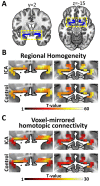Normal Olfactory Functional Connectivity Despite Lifelong Absence of Olfactory Experiences
- PMID: 32810869
- PMCID: PMC7727390
- DOI: 10.1093/cercor/bhaa217
Normal Olfactory Functional Connectivity Despite Lifelong Absence of Olfactory Experiences
Abstract
Congenital blindness is associated with atypical morphology and functional connectivity within and from visual cortical regions; changes that are hypothesized to originate from a lifelong absence of visual input and could be regarded as a general (re) organization principle of sensory cortices. Challenging this is the fact that individuals with congenital anosmia (lifelong olfactory sensory loss) display little to no morphological changes in the primary olfactory cortex. To determine whether olfactory input from birth is essential to establish and maintain normal functional connectivity in olfactory processing regions, akin to the visual system, we assessed differences in functional connectivity within the olfactory cortex between individuals with congenital anosmia (n = 33) and matched controls (n = 33). Specifically, we assessed differences in connectivity between core olfactory processing regions as well as differences in regional homogeneity and homotopic connectivity within the primary olfactory cortex. In contrast to congenital blindness, none of the analyses indicated atypical connectivity in individuals with congenital anosmia. In fact, post-hoc Bayesian analysis provided support for an absence of group differences. These results suggest that a lifelong absence of olfactory experience has a limited impact on the functional connectivity in the olfactory cortex, a finding that indicates a clear difference between sensory modalities in how sensory cortical regions develop.
Keywords: anosmia; homotopic connectivity; regional homogeneity; resting-state; sensory loss.
© The Author(s) 2020. Published by Oxford University Press.
Figures



Similar articles
-
Morphological changes in secondary, but not primary, sensory cortex in individuals with life-long olfactory sensory deprivation.Neuroimage. 2020 Sep;218:117005. doi: 10.1016/j.neuroimage.2020.117005. Epub 2020 May 30. Neuroimage. 2020. PMID: 32485304
-
Congenital olfactory impairment is linked to cortical changes in prefrontal and limbic brain regions.Brain Imaging Behav. 2018 Dec;12(6):1569-1582. doi: 10.1007/s11682-017-9817-5. Brain Imaging Behav. 2018. PMID: 29442274
-
Post-traumatic olfactory loss and brain response beyond olfactory cortex.Sci Rep. 2021 Feb 17;11(1):4043. doi: 10.1038/s41598-021-83621-2. Sci Rep. 2021. PMID: 33597627 Free PMC article.
-
Olfactory Loss and Regain: Lessons for Neuroplasticity.Neuroscientist. 2018 Feb;24(1):22-35. doi: 10.1177/1073858417703910. Epub 2017 May 1. Neuroscientist. 2018. PMID: 28459173 Review.
-
Functional MRI of congenital hyposmia: brain activation to odors and imagination of odors and tastes.J Comput Assist Tomogr. 2002 Jan-Feb;26(1):39-61. doi: 10.1097/00004728-200201000-00008. J Comput Assist Tomogr. 2002. PMID: 11801904 Review.
Cited by
-
Surgical Approaches for Possible Positions of an Olfactory Implant to Stimulate the Olfactory Bulb.ORL J Otorhinolaryngol Relat Spec. 2023;85(5):253-263. doi: 10.1159/000529563. Epub 2023 Mar 30. ORL J Otorhinolaryngol Relat Spec. 2023. PMID: 36996786 Free PMC article.
-
International consensus statement on allergy and rhinology: Olfaction.Int Forum Allergy Rhinol. 2022 Apr;12(4):327-680. doi: 10.1002/alr.22929. Int Forum Allergy Rhinol. 2022. PMID: 35373533 Free PMC article. Review.
-
Human hippocampal connectivity is stronger in olfaction than other sensory systems.Prog Neurobiol. 2021 Jun;201:102027. doi: 10.1016/j.pneurobio.2021.102027. Epub 2021 Feb 25. Prog Neurobiol. 2021. PMID: 33640412 Free PMC article.
-
Functional Connectivity of the Chemosenses: A Review.Front Syst Neurosci. 2022 Jun 22;16:865929. doi: 10.3389/fnsys.2022.865929. eCollection 2022. Front Syst Neurosci. 2022. PMID: 35813269 Free PMC article. Review.
-
Humans without a sense of smell breathe differently.Nat Commun. 2024 Oct 22;15(1):8809. doi: 10.1038/s41467-024-52650-6. Nat Commun. 2024. PMID: 39438441 Free PMC article.
References
Publication types
MeSH terms
Supplementary concepts
LinkOut - more resources
Full Text Sources
Medical

